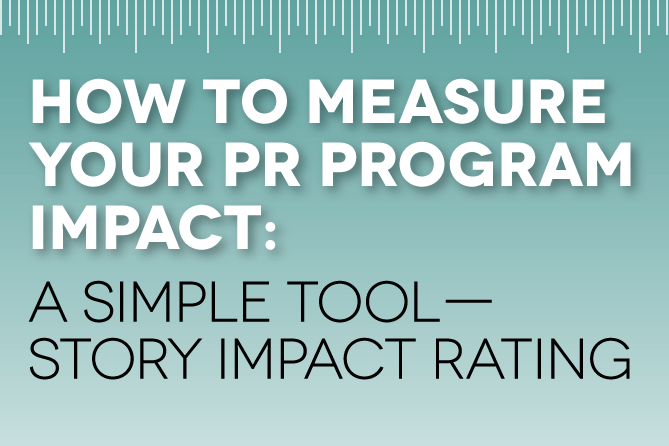 A standing joke among PR professionals is that we went into public relations to avoid numbers and “doing math.” But alas, we all know that math is a must—measuring the impact of our work is essential.
A standing joke among PR professionals is that we went into public relations to avoid numbers and “doing math.” But alas, we all know that math is a must—measuring the impact of our work is essential.
There are many different ways to measure the impact of your PR work. But to do it well, you need to know what matters to your organization. Identifying what matters should be laid out in your PR plan through a clear strategy, goals, measurable objectives and tactics for accomplishing them.
You can look online for comprehensive measurement tools or systems like those available from Cision. In this post, I’ll share information about a simple PR measurement tool that has been a mainstay in the PR industry. It’s called the “story impact rating” matrix (or SIR matrix). This SIR matrix is one that we’ve tweaked and modified over the years for our clients with a triple bottom line. At the end of this post, you’ll be able to download a free sample of our SIR matrix that you can modify to work with your PR plan.
How the SIR matrix works
The SIR matrix is an easy way to measure the impact of traditional media coverage beyond simply counting the number of clips you’ve received or audience impressions you’ve garnered through your PR outreach. It gives you a numerical scoring—or impact rating—for each clip based on your PR goals.
Each news story receives a story score based on certain factors that are important to your organization. These factors might include criteria like: the editorial tone of a story (is it positive or negative?); whether it includes a quote from your CEO; whether your organization’s industry, products and services are mentioned; whether your organization’s key messages are included; or whether a photo of your organization, products, CEO, etc. was included.
These factors are determined by what is most important to you—as described in your PR plan’s goals. Are you trying to increase visibility in your industry for your CEO? Then a factor related to your CEO might be appropriate in your matrix. Are you trying to increase understanding about what your organization does? Then a factor related to your key message or mission may be appropriate.
In addition to the story score, a news item also receives a media score. The media score indicates the importance you place on a particular media segment. For example, if your goal is to increase national visibility and awareness of your organization, national media outlets would be given a higher weighting in your matrix, whereas a local media outlet or a trade magazine may be given a lower weighting. Again, the media categories and weightings are determined based on your goals.
Next, do the math. The story score and the media score are multiplied to produce an overall impact score for that particular news item. You can aggregate these scores to get a total impact score or an average impact score for a specific time period (month, quarter, or year) depending on how often you want to report PR results to your organization’s management team.
How to measure your PR program impact?
The bottom line: There’s no avoiding the math; measurement is a must to determine the impact of your PR efforts. And your measurement tool should relate directly to your PR goals.
The SIR matrix is one tool that can help you measure the impact of your organization’s media coverage. We’ve developed other tools to measure the impact of other efforts within an integrated marketing communications program for our clients, like a social media scorecard (but that’s a tool and topic for another blog post).

